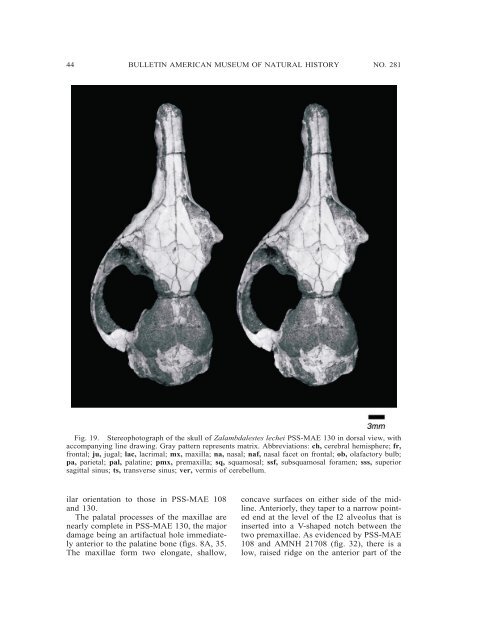zalambdalestes - American Museum of Natural History
zalambdalestes - American Museum of Natural History
zalambdalestes - American Museum of Natural History
You also want an ePaper? Increase the reach of your titles
YUMPU automatically turns print PDFs into web optimized ePapers that Google loves.
44 BULLETIN AMERICAN MUSEUM OF NATURAL HISTORY NO. 281<br />
Fig. 19. Stereophotograph <strong>of</strong> the skull <strong>of</strong> Zalambdalestes lechei PSS-MAE 130 in dorsal view, with<br />
accompanying line drawing. Gray pattern represents matrix. Abbreviations: ch, cerebral hemisphere; fr,<br />
frontal; ju, jugal; lac, lacrimal; mx, maxilla; na, nasal; naf, nasal facet on frontal; ob, olafactory bulb;<br />
pa, parietal; pal, palatine; pmx, premaxilla; sq, squamosal; ssf, subsquamosal foramen; sss, superior<br />
sagittal sinus; ts, transverse sinus; ver, vermis <strong>of</strong> cerebellum.<br />
ilar orientation to those in PSS-MAE 108<br />
and 130.<br />
The palatal processes <strong>of</strong> the maxillae are<br />
nearly complete in PSS-MAE 130, the major<br />
damage being an artifactual hole immediately<br />
anterior to the palatine bone (figs. 8A, 35.<br />
The maxillae form two elongate, shallow,<br />
concave surfaces on either side <strong>of</strong> the midline.<br />
Anteriorly, they taper to a narrow pointed<br />
end at the level <strong>of</strong> the I2 alveolus that is<br />
inserted into a V-shaped notch between the<br />
two premaxillae. As evidenced by PSS-MAE<br />
108 and AMNH 21708 (fig. 32), there is a<br />
low, raised ridge on the anterior part <strong>of</strong> the
















